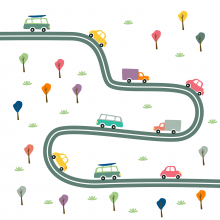How pothole misery is driving a digital roads revolution
Today’s topic is sure to gain a lot of traction with our listeners, and that’s because we’re talking about the state of our roads. Potholes are so maddening, they can send the most mild mannered among us into full blown road rage, cracking windscreens and wrecking wheels. And the problem seems to be getting worse…
Luckily researchers at Cambridge University are coming to the roaduser’s rescue: with digital facsimiles of the road network to help spot problem areas sooner, new materials that make road repairs last longer, and even an autonomous robot that can track down and fix up potholes before they ruin your tyres…
In this episode

01:17 - AA president laments state of UK's roads
AA president laments state of UK's roads
Edmund King, AA
We put in a call to the AA - the Automobile Association - who among other things campaign on behalf of road users. Naked Scientist James Tytko spoke with their president, Edmund King...
Edmund - The scale of the pothole problem is absolutely massive. At the AA last year alone, we actually dealt with 632,000 pothole related incidents. So that's where a car has hit a pothole, it's damaged the tyre, it's damaged the wheel, it's damaged the suspension, and it can cost thousands and thousands of pounds for individuals. In fact, we looked at all the breakdowns across the year and we actually predicted that if you looked across the UK as a whole, it would've cost drivers at least half a billion pounds in repairs. And that can be anything from £200 for a new tyre to £4,000 for new suspension.
James - Yeah, that's a staggering number you've been able to reach, there. And I suppose it's impossible to then calculate the cumulative disruption to people's journeys, the time lost as a result, the knock on to the economy? That number is likely to be far greater.
Edmund - Well, indeed, if you look at industry across the board, 1 in 10 people in the UK are reliant on vans for their work, for getting around, and obviously vans like other vehicles suffer from potholes. The other thing that actually makes it worse is that most vehicles today don't have a spare tyre. So if you hit a pothole, get a puncture, it obviously takes longer and it is more expensive to get it repaired. Whereas in the old days when you had a spare tyre, that could be quite a quick fix. One of the issues is that local authorities do go out there, they do fill in potholes, but often it is just a quick fix and it's a false economy because if that pothole is not resurfaced properly, that pothole will appear and reappear very often. We got together with British cycling, with the British Motorcyclist Council, and indeed some of the road repairers like JCB, and we've been calling upon the government not just for more funds, but for more permanent repairs. There is kit out there, there's a JCB Pothole Pro that can cut, clean and fill potholes in a much more permanent manner so that they don't reappear the next month or six months later or a year later. That's what we need in the UK. We need a different approach to filling the potholes on our roads.
James - It's become a very politicised issue, hasn't it? There's not a year goes by where the chancellor of whatever political affiliation doesn’t make some grand pledge in the annual budget announcement to spend more money on fixing potholes. But the problem just seems to be getting worse?
Edmund - Well, indeed. If you look over the last five years, we've had various emergency pothole funds of 50 million, a hundred million. Recently, the Prime Minister announced £8.3 billion would go into potholes and fixing the roads. That sounds like a brilliant figure, a very big figure, but when you analyse the detail, when you break it down, you'll see that that is over 10, 11 years and most of the money is backended for that period. Yes, we need more money, but the money needs to be ring fenced. What you often find with various local authorities, they have money allocated to them from the department for transport, but towards the end of the year when other services are under pressure, the road maintenance money is the first to give way, and that goes into other funds. So we want all the money that's allocated to be ring fenced. And we also want the local authorities, the highway authorities, to look at more permanent fixes rather than this patchwork approach that doesn't really work.

05:45 - Car sensors fuelling a digital infrastructure economy
Car sensors fuelling a digital infrastructure economy
Ioannis Brilakis, University of Cambridge
These days, modern cars are brimming with sensors making measurements about almost every aspect of the way the vehicle is performing, and - crucially - the condition of the road it’s driving over - how wet it is, how hot it is, even how bumpy it is, during every journey we make.
Now, at the moment, all this data resides with the car manufacturers. But researchers like Cambridge University’s Ioannis Brilakis are working on ways to marshall that data into forms that can be used to keep roads in better shape, going forwards.
This is the Digital Roads of the Future project, and the vision is to create a “digital twin” of the road network, updated constantly by data from drivers and used to spot the areas where potholes and other defects are beginning to develop and need attention before they become a major problem…
Ioannis - In the context of roads, we have a huge network out there of vehicles that have the ability now to collect data for us. We're getting to a point where the construction sector no longer needs to be involved in inspection. The car industry can do it for us quite effectively because they have the ability to capture video, accelerometer data, and several other modalities, including mini weather stations on the car. As a result of that, they can find the cracks, the potholes, the damaged lane markings, fallen street signs and other problems, and provide that information without us having to do a separate trip.
Chris - Who is doing this?
Ioannis - Mercedes is already doing this quite effectively. They have contracts in place with the Netherlands and Sweden and recently with TFL to provide such information, to the whole country in the case of Netherlands and Sweden. But the rest of the car sector is waking up to this and we can see Jaguar, Land Rover, Ford, and other businesses trying to get into that functionality.
Chris - Is this part of their business model then? Where previously their business was, they made a car and sold it to you and made money once and then made some money out of spare parts and a bit of servicing, now they've got this amazing sensor network on wheels. Is that where it's going?
Ioannis - Yes, I think Elon Musk showed the way when it comes to this by effectively positioning Tesla as a data company. All the other companies are trying to do the same because they understand there's a lot more value in using their own customers, the drivers, as data collectors rather than just simply selling the cars. This is what's happening. Mercedes is becoming a data company. They're now making a good part of their revenue through selling the data that comes through their customer vehicles, and this is only going to grow.
Chris - How much data are they collecting?
Ioannis - If I remember well, it depends on the car company, but from what I know from Mercedes, it's about 25 gigabytes per hour per vehicle. Of course, this is not all stored, only the useful extracted information is sent onto a Mercedes cloud and then Mercedes sections of that information into different categories and sells that as separate packages.
Chris - And is the world ready to receive this sort of information? Because that's one of the other projects that you've been working on here at the University of Cambridge, isn't it? That all this data can only be used if we've got a way of deploying it and interpreting it?
Ioannis - That's where we started with the Digital Roads programme. Going back to the example, we've used Mercedes, they are producing all this data, but our strategic road network with National Highways is simply not able to receive it. This is because of the growing gap between the technologies on cars in the car industry versus the technology on the infrastructure side. If we think about it, since the 1980s to today, cars have evolved from mechanical pieces to sensors on wheels, whereas infrastructure is still just as dumb as it used to be 40 years ago. Well, that doesn't fly. It doesn't work in the future. If we want to create modern infrastructure that's suitable for autonomous vehicles, we need to make the jump on the infrastructure side as well. Government can help by creating the kind of data set that can help all the car companies at the same time: digital twins. The biggest value of digital twins is forecasting and forensics. Looking back in time and looking forward in time. As I'm driving my car, I want to anticipate, predict, understand what might happen in the next five seconds, ten minutes as I drive ahead. If the car is reporting to the cloud that the road is slippery and it is wet, then the cloud can look at that information, run a simulation, and say that, given this information, you need to slow down, otherwise you have a very high chance of an accident.
Chris - So will your ultimate product be something that can marshal all of this data, put it into a format that then anyone can use in the way you've been describing? You are the sort of middleman here?
Ioannis - I could be wrong, but if I recall correctly the dataset that National Highways currently has has a value of well over 40 or 60 billion pounds. We need to unleash the power of that data set. We need to get to a point where this is not all hidden for the use of very few people, but it's actually public. Like the infrastructure, the physical infrastructure is public for everyone to benefit. That's what we're trying to enable in our use case following the maintenance path. We're trying to leverage the value from the inspection, from the cars, into the digital twins, and make predictions based on the information we receive. For example, if we have a really large pothole that's a safety risk, we need to fix it right away. Whereas if it's a little crack, that's something we can then put in next year's maintenance schedule.

11:37 - Smart materials promise long term road repairs
Smart materials promise long term road repairs
Abir Al-Tabbaa & Damian Palin & Sripriya Rengaraju University of Cambridge
Abir Al-Tabbaa is based at the University of Cambridge’s Engineering Department. She’s trying to find ways to solve two sets of problems: the short term issue of how to repair potholes right now and in a way that lasts for a reasonable length of time, by improving the materials we’re working with. She’s also got researchers working on ways to make surfaces more resilient in the future by embedding sensors into roads so they can self-report on their status; they’re even looking at implanting “radiators” to keep road surfaces warm in winter so they don’t crack in the first place, saving money on salt, grit and repair materials…
Abir - A pothole is a damage that is caused in asphalt pavements because it occurs when you get freezing and thawing. Normally, water will get into the asphalt, either through cracks or from the soil underneath, that will expand, the asphalt will also expand, and then the next morning when you get the thawing, it will move down or contract. That repeated process will eventually make the crack form into a pothole. Normally, you see the pothole growing quickly because of traffic.
Chris - And is that just because once you've broken down the integrity of the road surface, it's just weak and there's not so much binding things together?
Abir - Yes, that's the problem with asphalt, the weak bonding between the aggregates. The black stuff is bitumen, which comes from petroleum.
Chris - And that's the binder, that's what's sticking it together.
Abir - Correct.
Chris - Is asphalt the majority of what we use?
Abir - Correct. Most of our roads are asphalt pavements, particularly local roads. On the motorways, a number of these are concrete, but even at that national level, I believe only 4% of the strategic road network is concrete.
Chris - And are they equally susceptible to potholes or is one worse than the other?
Abir - Definitely one is worse than the other. Potholes only occur in asphalt pavements. Concrete is far more durable and resilient. Concrete is a lot more expensive, takes much longer to build, but mostly it is much noisier. Noise is a big problem on concrete roads.
Chris - So our challenge at the moment then is that the vast majority of our road stock is made of asphalt, is susceptible to potholing, has got bad potholing, and therefore is in dire need of repair.
Abir - Yes, that's correct.
Damian - My name is Damian Palin. I'm a senior researcher here at Cambridge working with Abir. We're looking at various strategies to enhance the performance of existing road materials on the road network.
Chris - Abir told us that, in asphalt, there is a binder, the tar, the bitumen that sticks everything together, and then stones, hard bits. What can you add then that makes that a better, more resilient road surface than what we have already?
Damian - One of the what you might call low hanging fruit options is to add fibres. By adding fibres to the bitumen, you can improve its fatigue performance.
Chris - When you say fibres, do you mean things like threads of cotton? That sort of scale?
Damian - Indeed. Could be. We're not using natural fibres or cotton, we're looking more so at using glass fibres, steel fibres. By adding something like glass fibres, you are taking over tensile loads and you're restricting the movements of the bitumen and therefore creating a stronger material. We're seeing 20% improvement of compressive strength and we're seeing a similar kind of level of improvement in terms of tensile strength.
Chris - The thing that really bothers the people who have to repair roads and, critically, the people who have to pay for people to repair roads, is the bottom line. What does this add in terms of cost and what do you recoup through not having to repair quite so often if this does what you think it's going to?
Damian - Indeed. Well this is a very interesting question. We're now thinking about whole life performance. The repair material itself is a small cost. It's actually the closing of the road that's the big cost. Some people project that it could be 10 times the cost to close the road in terms of economic value over not closing the road. That's what we're really trying to save on: better repair material, don't close the roads as much.
Chris - Let's hope you are right. One of the other things we can do more long term is to try to invest in ways that we can make roads better at telling us what's wrong with them in the first place and how they actually do go wrong so we know better how to fix them, how to perhaps make them more environmentally friendly when we fix them, and also make better materials that will last the distance in the first place.
Sripriya - Hi, I am Sripriya Rengaraju. I'm a senior researcher. I'm looking at implementing different kinds of sensors to understand what is really happening in the field in terms of road infrastructure. Longevity will help us to go for a longer duration without any intervention for repair and that's low carbon. One of our key motivations is to implement different kinds of sensors so we understand what is the threshold at which we need the intervention to happen.
Chris - When you say sensors, do you literally mean we put electronic devices into the road surface and they're telling us what condition the road is in? It's a bit like me implanting a device into my body to tell me what my heart's doing?
Sripriya - It is similar to that. We have different kinds of sensors. One, we can embed it in the infrastructure, and some can be on the surface. They can be mounted later for monitoring. Different kinds of deterioration happen on the road surface. It could be because of the environment and, now, with the advent of electric vehicles, we have different types of vehicles coming onto the road which the road was not actually designed for.
Chris - What sorts of information can the sensors give you and how do they actually work? What are they measuring?
Sripriya - One is monitoring temperature, humidity, the freeze thaw and even how much water stagnates on the road surface. Then, there are other kind of sensors which can monitor the stress development in the material, whether the vehicular movement is causing some stress and what kind of vehicular movement is causing that stress.
Chris - That would tell you a lot about how a road surface is coping with all the different challenges we are throwing at it. What about the other aspiration that Abir and Damian have both mentioned, which is making people who have to repair roads a bit less busy, roads that can repair themselves? We can do that for concrete. We can make materials that will heal a cracking concrete. Can we do that for asphalt and how can we do it better?
Sripriya - There is a lot of research now ongoing for self-healing asphalt. One of the things we can do is we can have heated ribbons. When it snows, what happens is the bitumen and the aggregates contract and, because of that, there will be a crack formation. But when you have a heated ribbon in place, this contraction will not happen.
Chris - It's almost immunising a road against cracks and potholes, isn't it? Because if the road stays warmer, the mechanism of: getting water in, ice formation, cracking, it doesn't happen in the first place. And the warmth presumably means that stuff stays more flexible.
Sripriya - Yes, exactly. That is the mechanism. What we are targeting at is, can we use the existing roads and make them last longer? That is the idea.

19:17 - Exploring the A12 in virtual reality
Exploring the A12 in virtual reality
Lilia Potseluyko, University of Cambridge
As Ioannis was explaining earlier, he’s working on a system that will harness real-time data collected by cars to produce a “digital twin” of the road network, complete with all of its potholes and other imperfections. The idea being, of course, that the highways agencies responsible for making repairs know where to focus their efforts and even, as we’ll hear in a moment, where to deploy autonomous robotic repair vehicles to fix problems at the earliest stage before they become a nuisance.
So what might this digital twin look like?
These computerised replicas of the physical world can allow workers to actually - in virtual reality - walk along sections of roads and inspect the surface and any defects. They’ve got a mock-up of the system in operation. James got strapped in to take a wander down a section of a major A road near Colchester…
James - I've been very lucky to be shown a demonstration of what the data collecting capabilities of the cars on our roads are able to produce in the virtual world. So if I can get you to imagine, I've put on a VR headset, I'm in something akin to a giant baby walker, and beneath my feet are sensors so that when I move my feet along the surface of them, I'm moving my character in this virtual world. The VR headset is giving me the capability of looking around and observing my surroundings. In this particular demonstration, I'm on a stretch of the A12 where there are a number of points of data interesting to National highways, I expect. There's information about a pothole that's formed in this part of the road, road signs have been rendered in for me. As I look around and explore this virtual reality, I'm starting to get to grips with what the 'sensors on wheels,' as they've been described to us, are actually able to give the companies for their repair purposes, et cetera. I can run around without getting run over as well. There's no cars on the road, which is a blessing to be honest, because I don't think I'd survive long out here.
James - The technology's back in the hands of the professionals, I'm glad to say.
Lilia - I'm Dr Lilia Potseluyko. I'm an industrial research fellow in digital twins. This is the data set collected from a section of the A12 road. What we are hoping to achieve in the future is for traffic maintenance professionals to be able to get this data real time and be able to use it to predict what would happen next and which section of road to prioritise for repair.
James - The virtual reality section of the A12 we are wandering around in today. Where's the data come from exactly to build this digital twin?
Lilia - So currently it's been collected by a contractor to National Highways.
James - So the idea will be that we'll be getting more data from the actual sensors on the cars that's being uploaded in vast quantities as we were hearing about earlier?
Lilia - Yes. From this data we could get the best use to create the most realistic virtual environment that we can. What we are planning to achieve is for software to be able to create a semantic segmentation of the data so the traffic officers don't need to search for the defects themselves on the road. The software will be able to identify it for them.

23:05 - Robot van patches over potholes automatically
Robot van patches over potholes automatically
Richard Anvo, University of Cambridge
Once we have a working digital twin for the highways, we can potentially deploy van-sized autonomous repair vehicles, not dissimilar to the machines exploring Mars, to track down defects and put them right, hopefully without coning off too many lanes, or too many sets of temporary traffic lights!
Richard Anvo is developing the pothole repairing robot…
Richard - The project is about a mobile robotic platform to be able to fix roads automatically, fixing potholes or cracks. So we're looking at the scale of a van, holding all the equipment from the robotic side to do the repair automatically.
Chris - I suppose it must be similar to the sorts of problems that are being solved to explore Mars. We've got autonomous vehicles following instructions, but they're largely self-directed, going and doing things to a surface, drilling, taking samples and so on. There must be many commonalities there?
Richard - Yeah, here the vehicle looks similar, but in the first place you drive the vehicle to where you need to repair. So the digital twin system tells the robotic system, 'Go to this area. There are some defects to be repaired' and from there we do the work automatically. It can clean the surface, you'll be able to repair the cracks, fix the pothole and do the lane marking at the same time.
Chris - Is anyone doing this anywhere else in the world yet? Do you have any kind of lead to follow or are you pioneering this?
Richard - A lot of research is going on, but I think our system is unique because it comes with the digital twin at the same time. So it is not just the robotic system only.
Chris - If you can get this to work, what sort of a difference can this make?
Richard - It will make a huge difference because it will save a lot of money and time. This one will tell exactly what to fix and where to fix.
Chris - And how long, dare I ask - and don't say five to ten years because everyone says five to ten years - how long before we probably will see these things trundling down the road and repairing all the potholes. Tell me tomorrow!
Richard - I think we can say soon. We're talking about a couple of years.
Chris - It's coming but we're going to have to be patient.
Richard - Yes.










Comments
With the transition to
With the transition to electric vehicles that are significantly heavier than comparable internal combustion engines vehicles, more potholes are inevitable. The damage that a vehicle does to a road is proportional to the 4th power of the weight, a 50% increase in vehicle weight will cause nearly 5 times the damage.
Add a comment